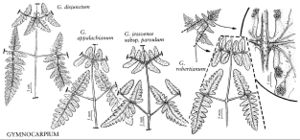Gymnocarpium appalachianum
Syst. Bot. 18: 161. 1993.
Stems 0.5–1.5 mm diam.; scales 1.5–3 mm. Fertile leaves usually 10–32 cm. Petiole 6–20 cm, with sparse glandular-hairs distally; scales 2–5 mm. Blade broadly deltate, 2–3-pinnate-pinnatifid, 4–12 cm, lax and delicate, abaxial surface and rachis glabrous or with occasional glandular-hairs, adaxial surface glabrous. Pinna apex entire, rounded. Proximal pinnae 3–10 cm, ± perpendicular to rachis, with basiscopic pinnules ± perpendicular to costa; basal basiscopic pinnules stalked or sessile, pinnate-pinnatifid or pinnatifid, if sessile then with basal basiscopic pinnulet (division of pinnule) always shorter than adjacent pinnulet; 2d basal basiscopic pinnule infrequently stalked, if sessile then with basal basiscopic pinnulet shorter than adjacent pinnulet; basal acroscopic pinnule occasionally stalked, if sessile then with basal basiscopic pinnulet shorter than adjacent pinnulet. Pinnae of 2d pair usually stalked, if sessile then with basal basiscopic pinnule shorter than adjacent pinnule and equaling basal acroscopic pinnule; basal acroscopic pinnule shorter than adjacent pinnule, often with entire, rounded apex. Pinnae of 3d pair usually sessile with basal basiscopic pinnule shorter than adjacent pinnule and equaling or shorter than basal acroscopic pinnule; basal acroscopic pinnule equaling or shorter than adjacent pinnule. Ultimate segments of proximal pinnae oblong, entire to crenate, apex entire, rounded. Spores 27–31 µm. 2n = 80.
Habitat: Maple-birch-hemlock (Acer - Betula - Tsuga) woods on mountain slopes and summits, on moist sandstone or talus slopes with cold air seepage (algific)
Elevation: 200–1400 m
Distribution

Md., N.C., Ohio, Pa., Va., W.Va.
Discussion
Gymnocarpium appalachianum, restricted to the Appalachian region, is a very local endemic.
Of conservation concern.
Selected References
None.
Lower Taxa
"-3timeslengthofblade" is not declared as a valid unit of measurement for this property.
